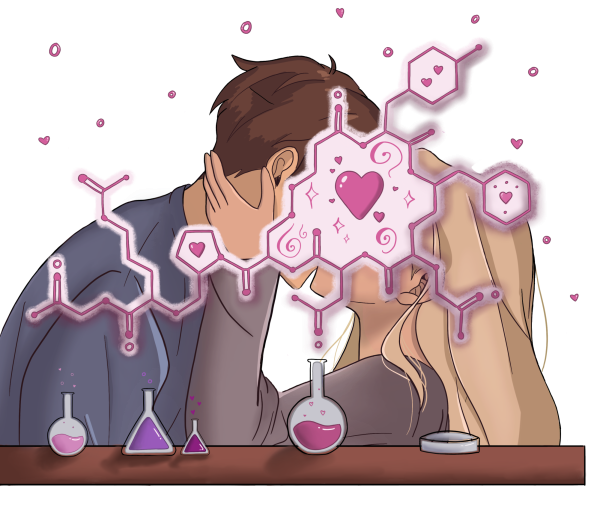Love is beautiful, irrational, pure and unruly.
It’s what unites Romeo and Juliet in Shakespeare’s masterpiece, Rose and Jack in “Titanic” and every other exalted couple in entertainment. Love has a tight grip on music, as the entire industry is hooked on heartache and desire. Take Haddaway, who examines love in his one-hit wonder “What Is Love.” Looking past the catchy beat of the ‘90s tune, Haddaway inquires after a subject that has puzzled humanity since the dawn of time.

Naturally, researchers have turned to science for answers. Unfortunately, science has restricted love to the inadequate confines of chemistry, identifying love as nothing more than the effects of oxytocin, the love hormone. To unpack why oxytocin falls short of defining love, we must dive into its function and impact on the nervous system.
Oxytocin regulates aspects of the male and female reproductive systems, as well as behavioral interactions of arousal, trust, romantic attachment and parent-infant bonding. Produced in the hypothalamus, the hormone is released by the pituitary gland to stimulate positive emotions.
Its tendency to promote excitement and other feelings associated with affection has led numerous scientists to label the hormone as the true definition of love. Of course, chemical reactions are often byproducts of the strong emotions love can cultivate. Even so, with an experience so unconditional and irrational, the question must be raised of whether oxytocin fully encapsulates love’s essence as a deep, universal sensation.
The National Library of Medicine contends that no arrangement of molecules will sufficiently describe the intricacies of love. To understand this profound truth, love must be defined in concrete terms.
Psychology Today outlined three essential characteristics of love: positive responsiveness, authentic connection and stability. Positive responsiveness encompasses displays of affection and strengthening another’s self-worth through validation and support. Similarly, authentic connection relates to love’s encouragement of togetherness and vulnerability. These factors contribute to stability, or the idea that love stems from personal steadiness rather than uncertainty or impulse. Stability composes the unconditional aspect of love that highlights dependability, acceptance and trustworthiness.
Hara Estroff Marano, a chief editor of Psychology Today, describes love as the cornerstone of humanity and the sole catalyst for personal growth. Affirming that love is an absolute necessity, she concludes that its value rises above the risks and effort involved in a relationship.
It’s evident that love wears many faces. However, love ultimately boils down to a choice. It is a subconscious decision one makes to prioritize another’s needs and feelings as much as, or even above, their own. It transcends emotions and science, determining how we understand ourselves and others. Love requires sacrifice and often begets pain, but it is an indispensable aspect of the human experience.
Hormones, including oxytocin, play an undeniable role in attraction. However, enduring relationships do not rely on hormones alone. Actions make or break the connection, and longtime partners actively choose to love one another once their frenzied hormones have calmed. The phrase “love is a verb” is highly applicable, as displaying gratitude, appreciation and devotion toward one’s partner are among the most sincere demonstrations of love.
By reducing love to a chemical reaction, we dehumanize ourselves and water down our affinity to scientific processes that fail to capture love’s transcendent quality. Of course, some continuously contend that chemical reactions are responsible for love’s violent affections. However, this argument mistakes love for infatuation, a strikingly different emotion.
Infatuation is synonymous with obsession. Characterized by “head over heels” giddiness, infatuation involves attachment based on the idealization of an individual one may not know very well. Although passionate, it’s acutely superficial.
On the contrary, love embraces a person’s individuality and calls for genuine intimacy, establishing a connection that brings out the best of both partners. Whether it’s romantic, familial or platonic, love allows one to be fulfilled and comfortable in their relationship. Of course, it’s possible for infatuation to evolve into love, but this can only be achieved if ideal fantasies of a person are relinquished. As a whole, infatuation fails to meet love’s depth and stability.
Few things in human history are as constant as love. Whether it’s your mom’s home-cooked meals or a friend offering a shoulder to cry on, love is the driving force of humanity, the one thing that keeps us grounded in a chaotic world. It never fails in its perseverance of hope, trust and protection. We often take the love that surrounds us for granted, but it’s crucial to acknowledge this blessing of compassion in our lives.
Love is many things, but ultimately, it’s a leap of faith. It’s a decision that places another’s concerns above our own, emphasizing personhood and the beauty of human connection. Transcending science, including the effects of oxytocin, love is the essence of humanity and stems from a universal desire for acceptance. Understanding the true definition of love prompts us to effectively express our devotion to others and ponder the immense, timeless power of this unseen force.
The abridged version of this article appeared in the Spring 2024 print edition. This is an uncut version.



Thomas Jay Oord • May 23, 2024 at 11:53 am
Thanks for your article! I argue similarly in a number of books, including Defining Love and The Science of Love. But your prose is very accessible.
Thanks!
Thomas Jay Oord